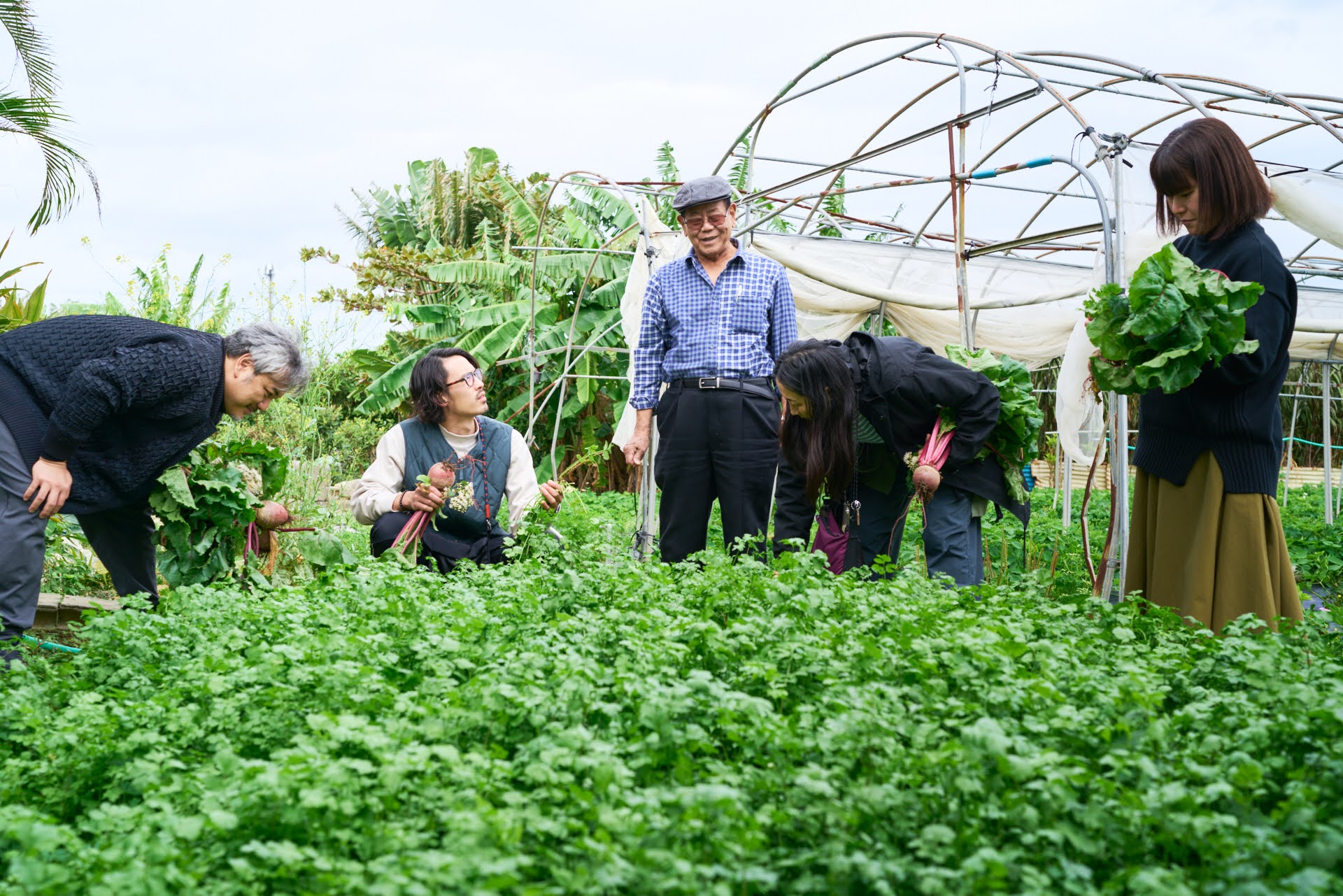In Nanjo City, located in the southern region of Okinawa’s main island, there is a farm with a vast herb garden. This organic garden is filled with sunlight and as you walk among the vigorously growing plants, you can feel your body naturally become energized and refreshed.
This heavenly herb garden was created by Shimoji Seikichi, founder and chairman of the company Okinawa Chosei Yakuso Honsha.
His company is known for their turmeric supplement, Ryukyu Shugo Densetsu, which was co-developed with The University of the Ryukyus. Ever since the company was founded, they have been cultivating organic herbs in Okinawa.
“The people of Okinawa believe that “food is medicine” and still use medicinal plants for health purposes. If you know where to look, you can even find medicinal plants growing on the side of a road.”
Shimoji Seikichi is a cheerful man who is full of good humor. He guided us through his medical plant garden, telling the occasional joke as he introduced the herbs to us.

Shimoji tends to the plants in his garden everyday. He has a deep passion and high aspirations for medicinal herbs and we spoke with him to experience medicinal plants firsthand.
Faith in his grandmother nurtured his interest in medicinal plants
Shimoji was born on Miyako Island of Okinawa in 1945.
At the time there was no hospital on the small island. When he was a child he was treated for illness and injuries with home remedies.
“My grandmother would take me to the mountains and fields to show me which medicinal plants I should use when I have a fever or want to treat a wound. If I had a cold, she picked medicinal herbs from around our neighborhood and made me tea with them.”
When Shimoji was in elementary school, he fell from a tree and broke his arm.
His grandmother wrapped his arm in chicken skin and cilantro leaves and braced it with a wooden plank. He was skeptical at first that this would help his wound, but in a few months his arm had healed beautifully with no lasting problems.
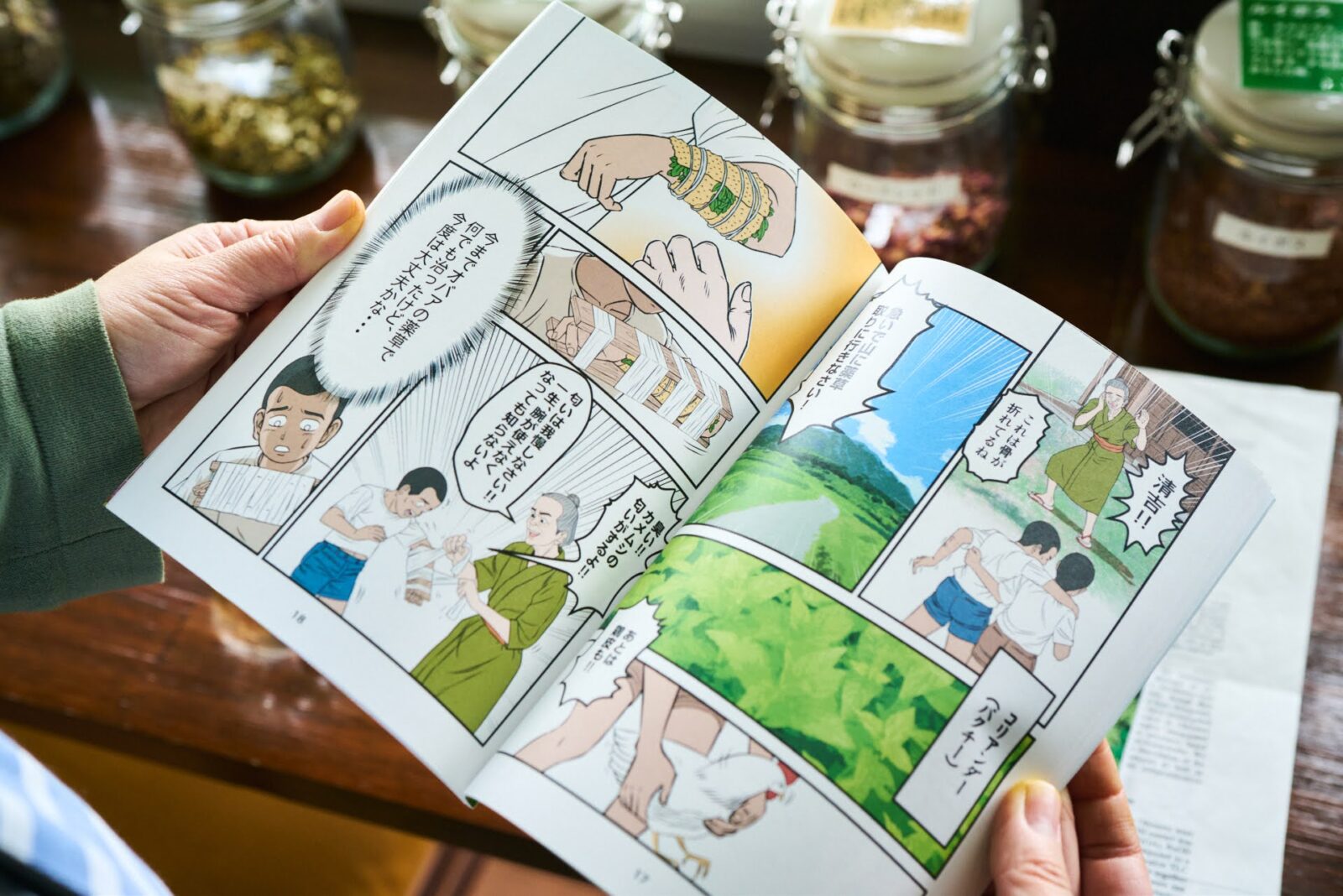
Shimoji says, “The grandmothers of Okinawa knew everything. Living in this environment gave them the knowledge and experience on how to use medicinal plants.”
Shimoji’s interest in medicinal plants was nurtured through such childhood experiences. As he grew older, his interest deepened and he spent much of his spare time collecting, cultivating and researching medicinal plants.
He wondered if he could use the wisdom of his ancestors and the knowledge he gained through his own research for the benefit and health of people around the world.
This desire grew in him and in 1972 he founded Okinawa Chosei Yakuso Honsha.
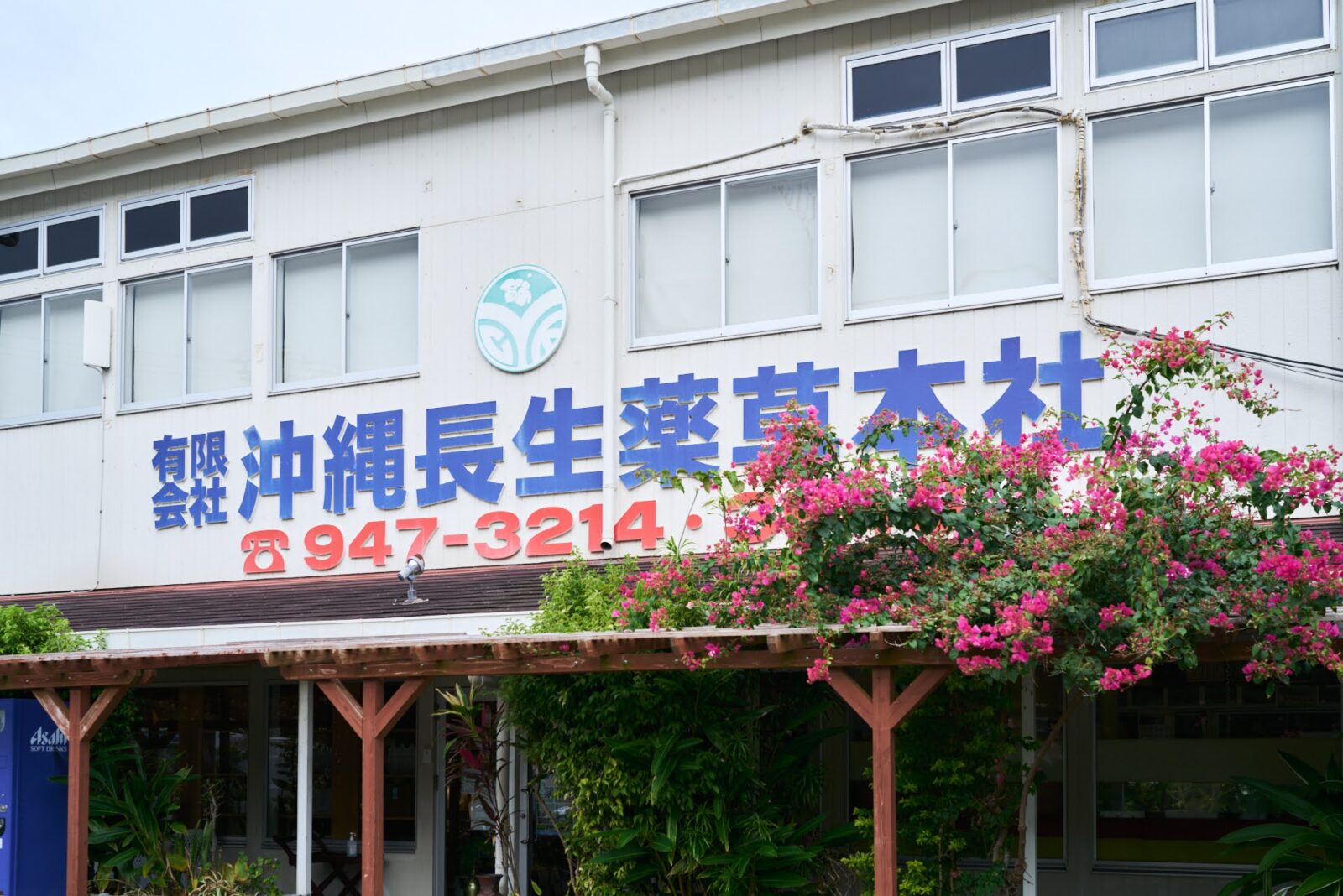
Traveling to the ends of the earth to find new medicinal plants
The Okinawa Chosei Yakuso Honsha’s medicinal herb garden is over 14,876 square meters in size. They cultivate over 1,000 varieties of medicinal herbs on that land. In fact, there are so many varieties growing so vigorously that even Shimoji cannot keep track of all of them.
For over fifty years, the plants have been grown without pesticides. They obtained the Food Safety Management system ISO22000 certification for the factory where they process their medicinal plant products and they are also a JAS certified organic farm.
“This here is banana mint. Try picking and smelling it. Over here is Mexican Sweet mint. It tastes sweet if you bite into it. All of these are different varieties of mint. I think we have about 30 varieties of mint alone.”
Shimoji carefully explains each plant to us as we walk around the garden. As we touch, smell, and taste the plants we find it fascinating that each plant has a distinct character, even if it is of the same variety.
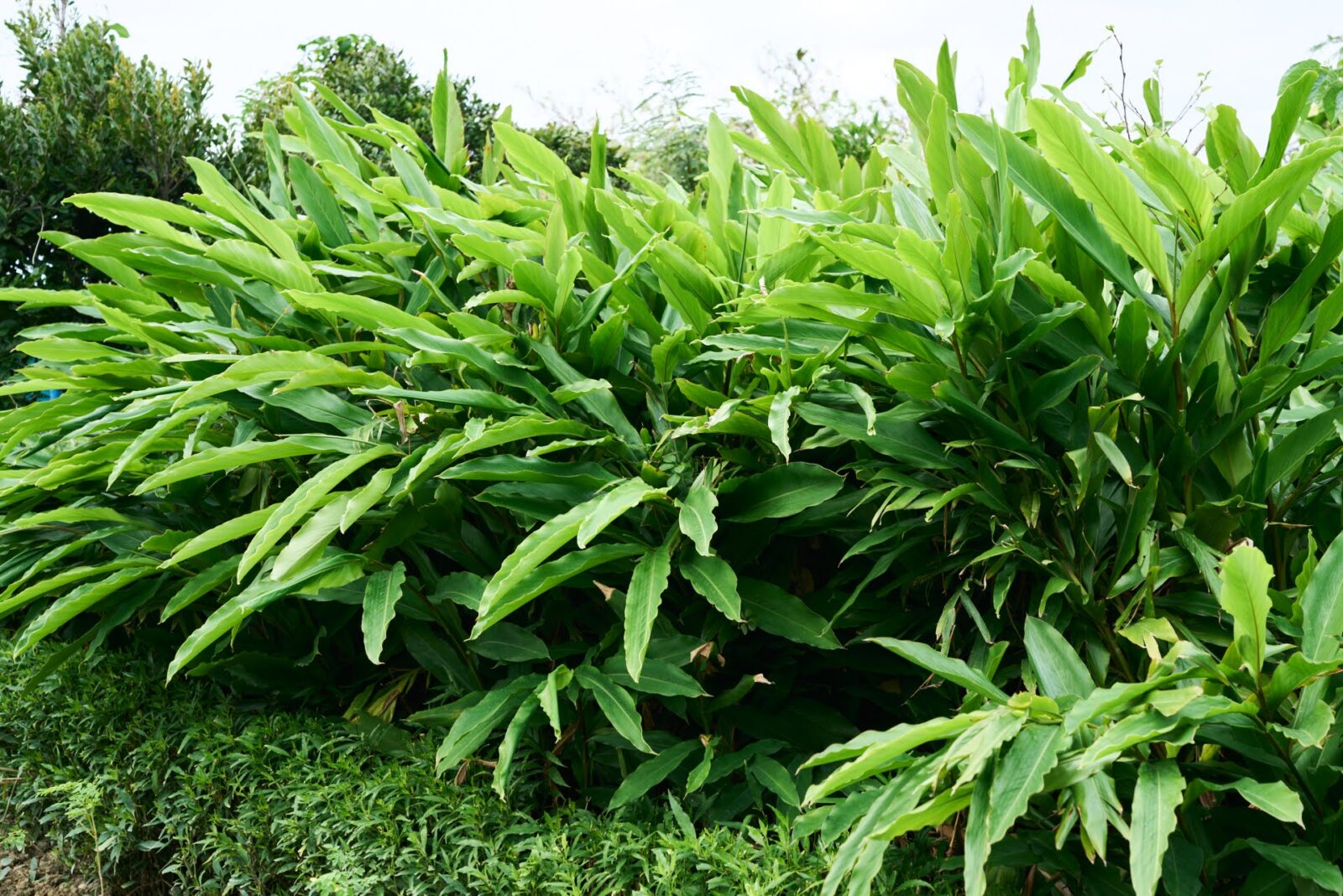
The more we walked around with Shimoji and learned about his plants, the more our interest grew.
Shimoji’s exploration of medicinal plants goes beyond Okinawa. He not only travels around Japan, but he also travels the world in search of medicinal plants. He is like the famous botanist Tomitaro Makino, from Kochi Prefecture, and travels to all corners of the earth seeking medicinal plants.

“Most of the plants in our garden are native to Japan, but about 20% are plants that I introduced from overseas.”
“I was the first to introduce plants such as mulukhiya, ginseng, dragon fruit and roselle to Japan. There are probably about 100 plants that I introduced. I lost track of how many countries I have visited, but I think I traveled Asia the most.”
Shimoji explored the harsh wilderness of the Mongolian mountains and even climbed Paektu Mountain, which borders China and North Korea, to find alpine plants.
Shimoji jokingly shares, “You have to incorporate enjoyment in work and exploration. It would have been more fun if I had a girlfriend to travel with, but it was always with a bunch of men.”
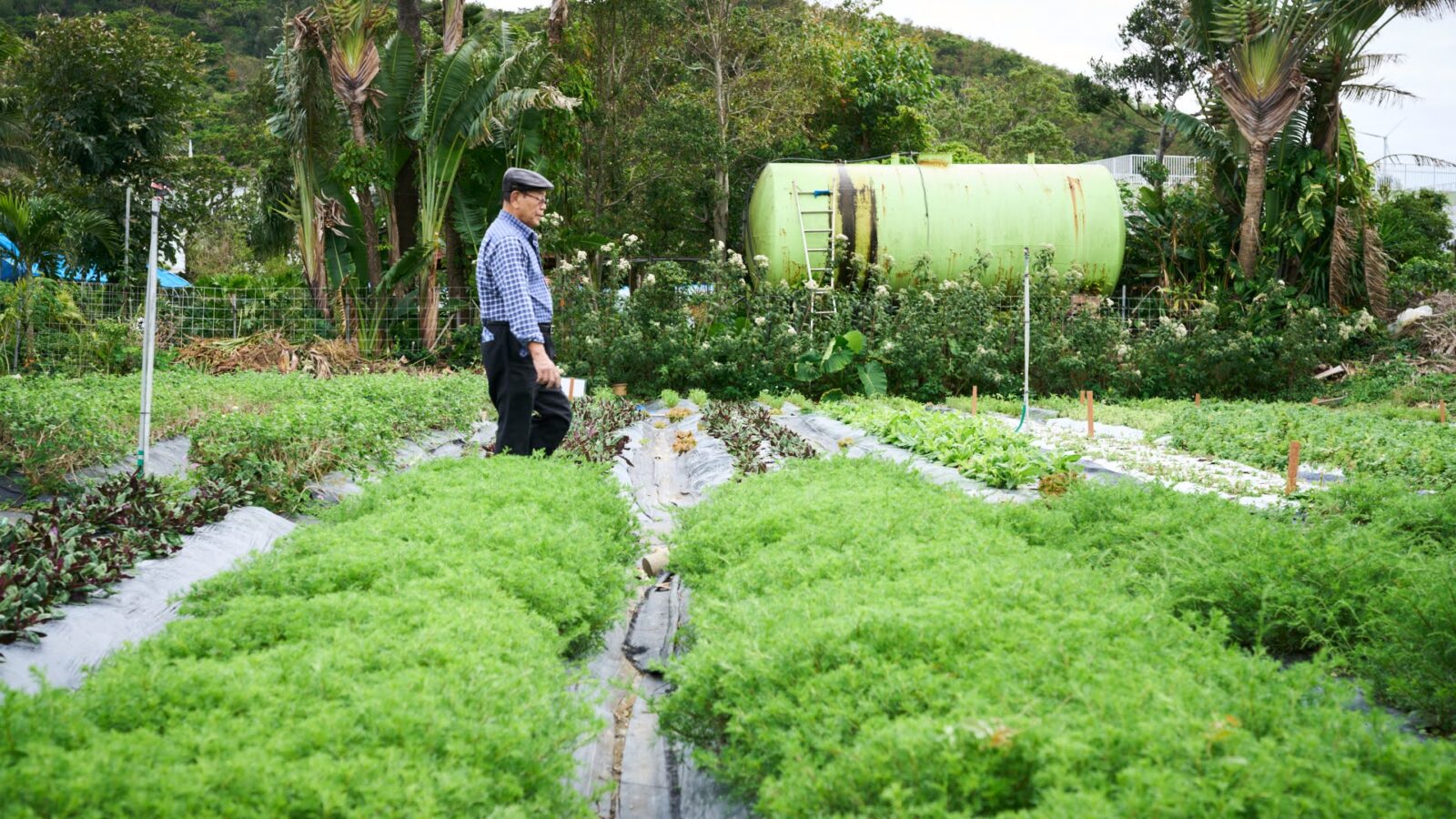
Perhaps due to Shimoji’s charming personality he is very well liked. As we walk around the garden his young staff approach him to say hello and they all seem close. A volunteer who likes herb gardens and comes to work in the garden also approached Shimoji for a friendly chat.
Even the cats who leisurely roam the garden follow Shimoji around. Not only plants, Shimoji seems to be adored and relied on by all people and animals and he is like a teacher or fatherly figure to them.
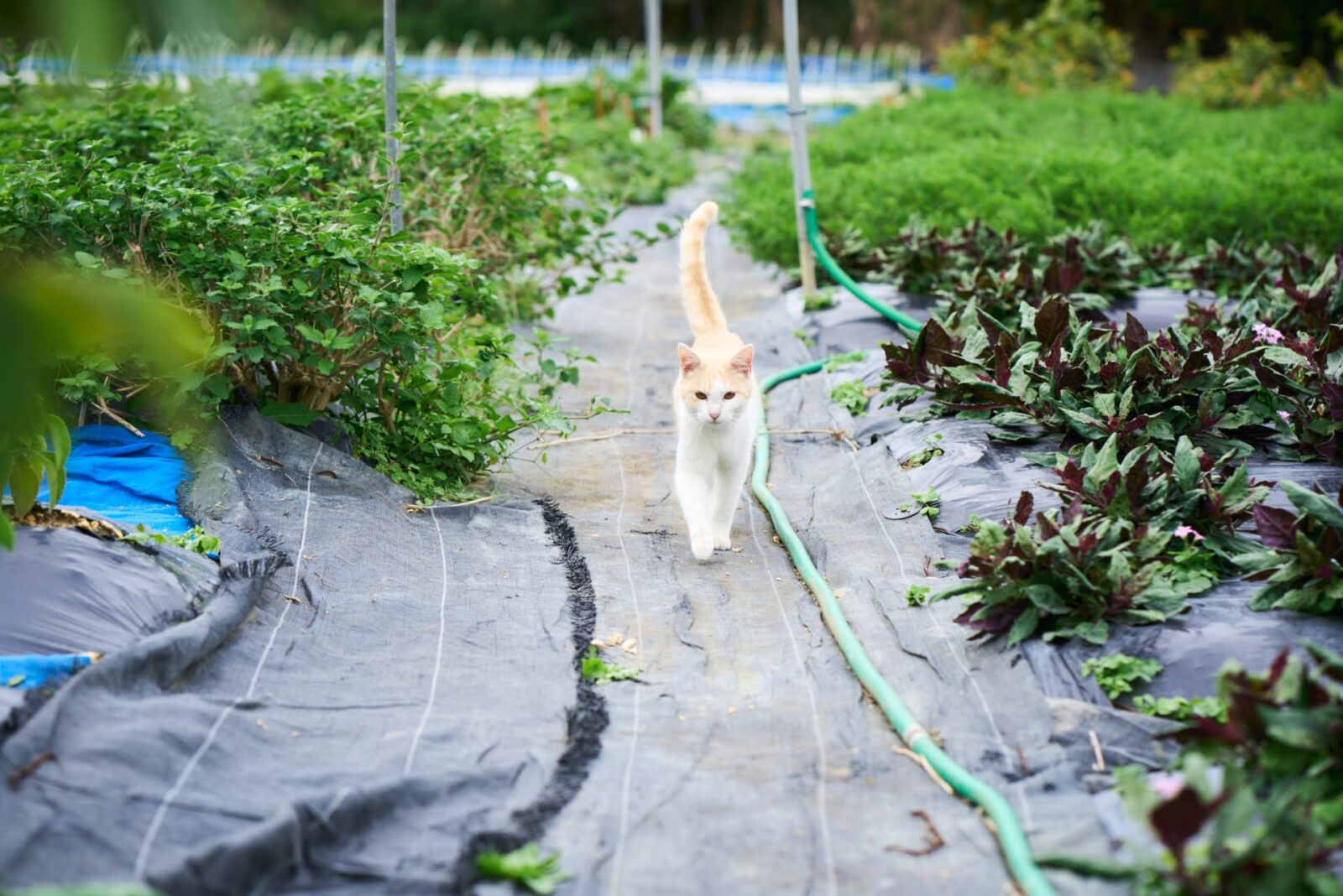
Turmeric, the great medicinal herb that traveled from Okinawa to outer space
One focus of Shimoji’s medicinal plant cultivation is turmeric. The Okinawa Chosei Yakuso Honsha manufactures and sells many products using turmeric.
Turmeric has been a popular health food in Okinawa since the days of the Ryukyu Dynasty. There are many varieties of turmeric, which is a member of the ginger family. Varieties include spring turmeric, fall turmeric, white turmeric, and a new variety developed by Shimoji and his company called the Okinawa Ogon Turmeric.
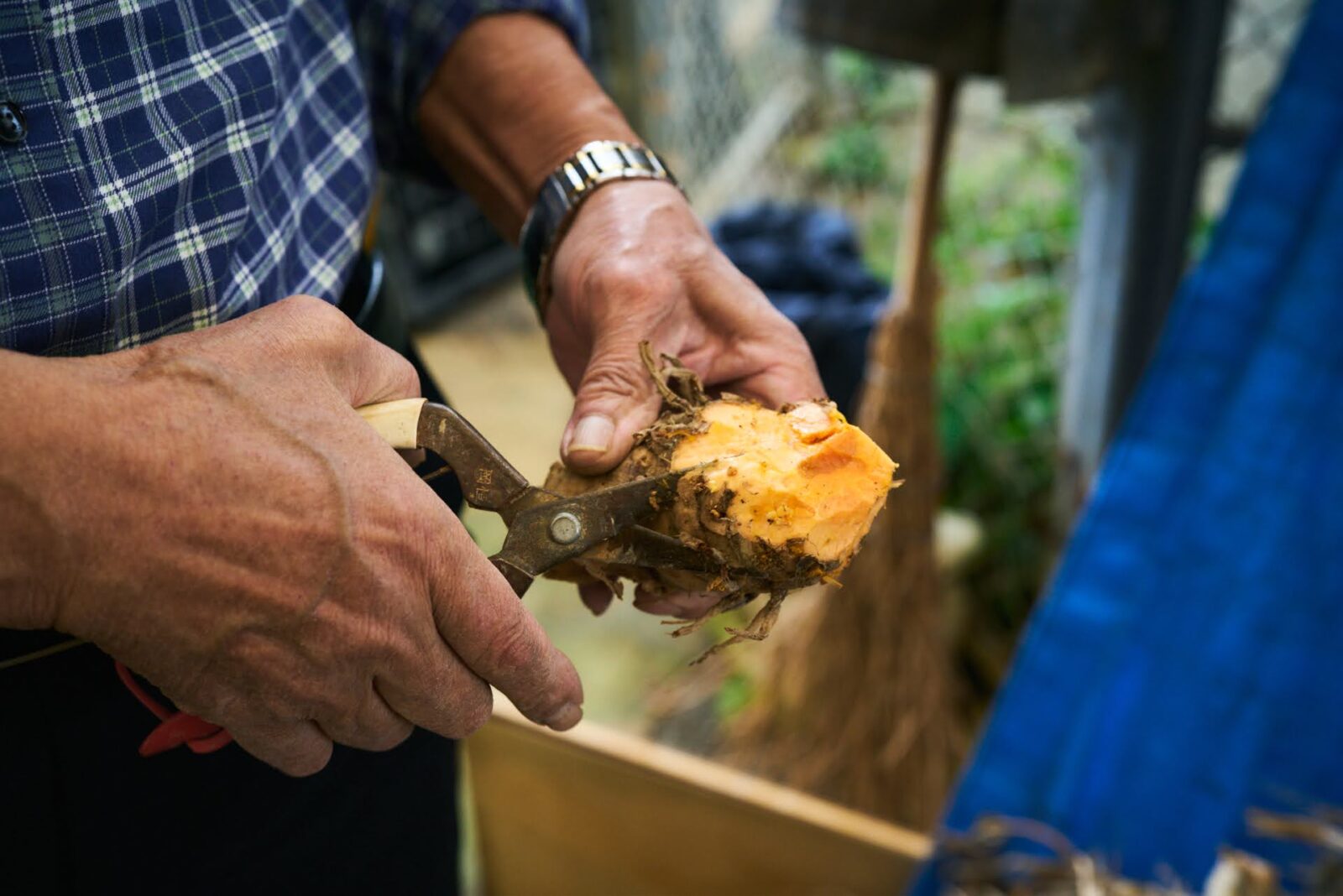
It is a variety of autumn turmeric, but is five times bigger and has larger leaves and is bigger in height. They found that it has a significantly higher level of curcumin, which is said to have antioxidant effects. Research on this new variety is ongoing in collaboration with universities.
We took a small bite of the raw turmeric and were surprised by the intense and numbing bitterness, almost like an electric shock running through the body. Even after some time, you can feel the power of the plant as your whole body begins to feel warm.
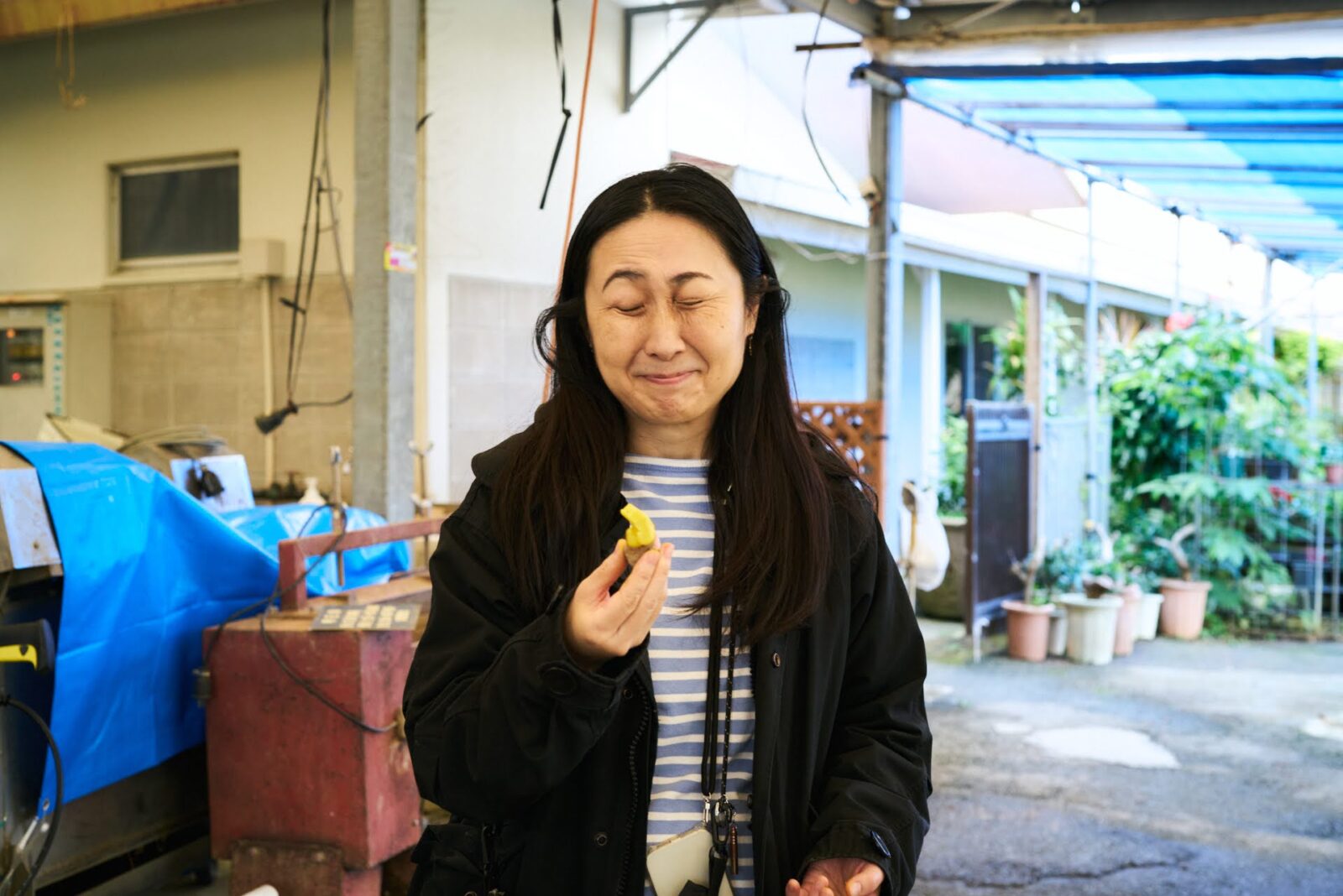
One of Okinawa Chosei Yakuso Honsha’s most popular product is a supplement called “Syugo-Densetsu”(Legend of Heavy Drinker). If you are an alcohol drinker in Japan, you have probably heard of this product before.
Although the products’ name is very catchy and leaves a strong impression of being related to alcohol, the supplement was developed as a daily health product for everyone, whether they drink or not.
The ingredients are all grown organically and are 100% natural, with no preservatives, coloring, or antioxidants.
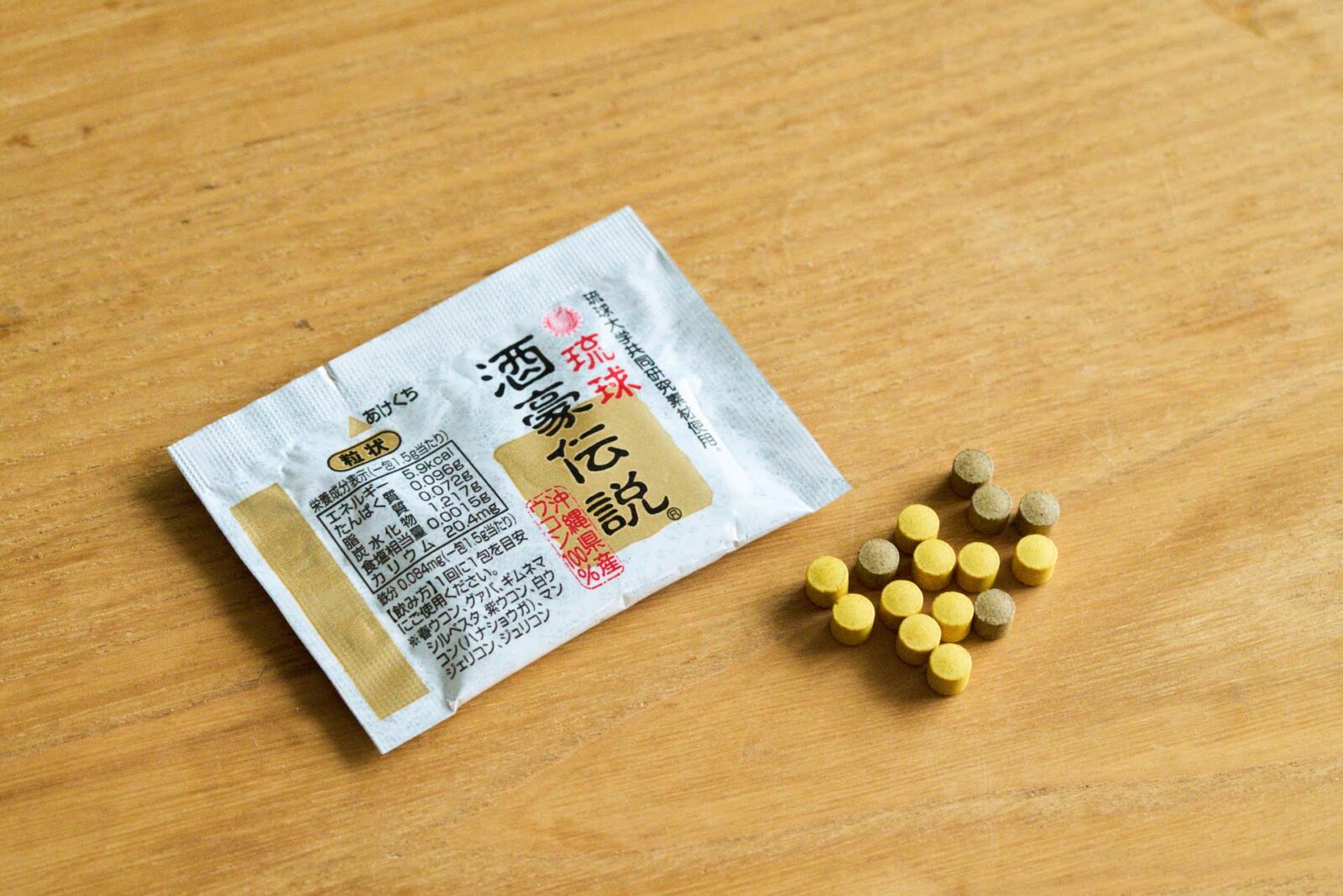
Their turmeric products have received numerous awards, including the Emperor’s Cup, the Ministry of Agriculture, Forestry and Fisheries Award and more. In 2006, the company received an audience with the Emperor and Empress and was awarded the Cabinet Office’s Merit Award for Promoting Okinawa.
Most amazingly, in 2011 their product traveled to outer space onboard NASA’s space shuttle Discovery (STS-128).
Shimoji smiles and says, “Maybe now even the aliens in outer space know that turmeric is good for health.”
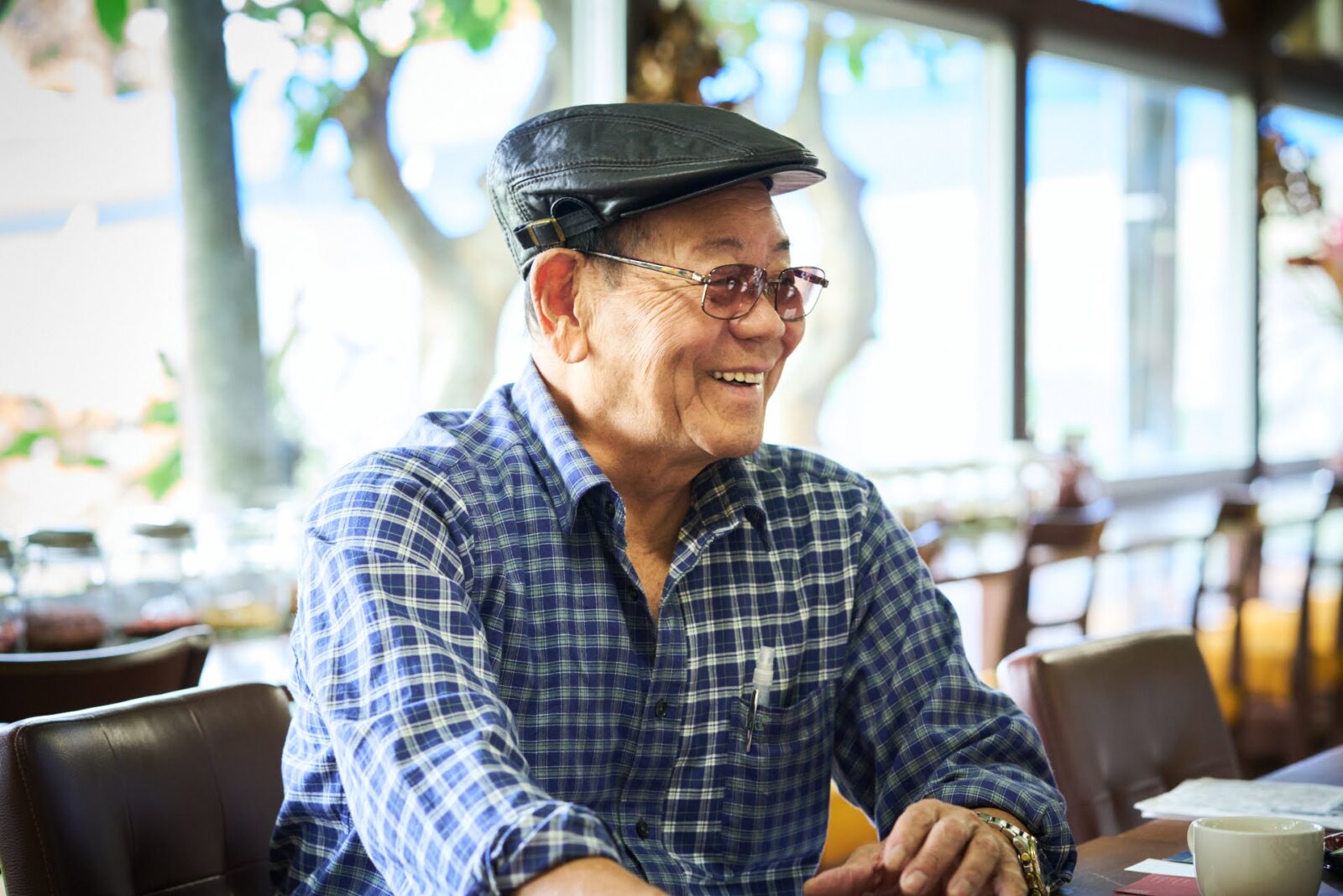
Making various herbal teas from the company garden
Another distinctive product made by Shimoji’s company are their various herbal teas made from the medicinal plants grown in their vast garden. Shimoji says that when they first started out their herbal teas did not sell at all, but through steady promotion and traveling around Japan, the number of consumers who felt the health benefits of their teas grew and the quality and effects of their herbal teas began to be recognized.
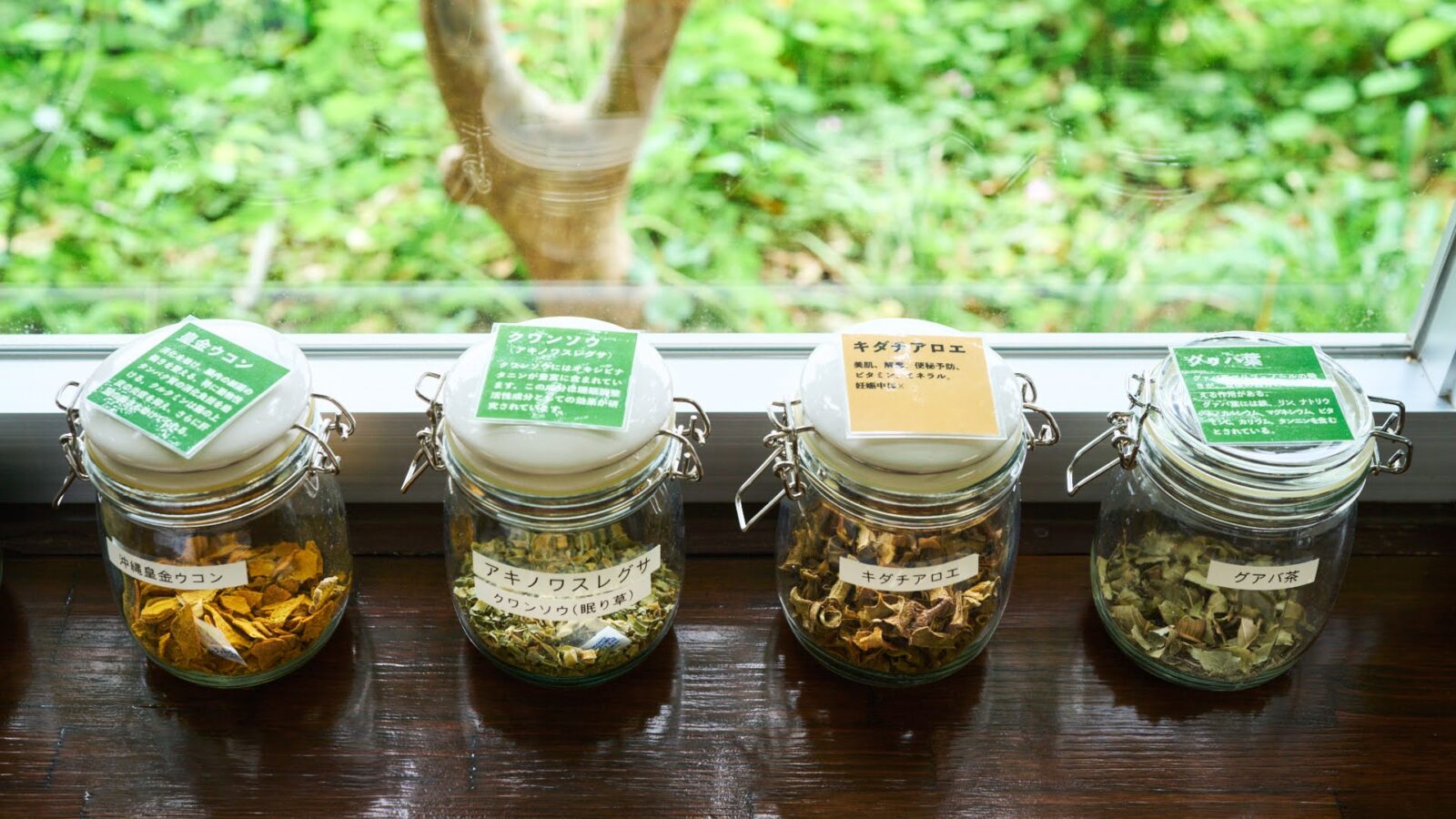
We tasted one of their teas which was a blend of 38 different medicinal herbs.
The 38 herbs are said to represent 38 parts of the human body, including the head, body, feet, toes, etc. Of course the tea includes turmeric, but it also contains dokudami, rose, lychee, safflower, kale, guava, polyporaceae, coriander and many other prominent medicinal herbs.
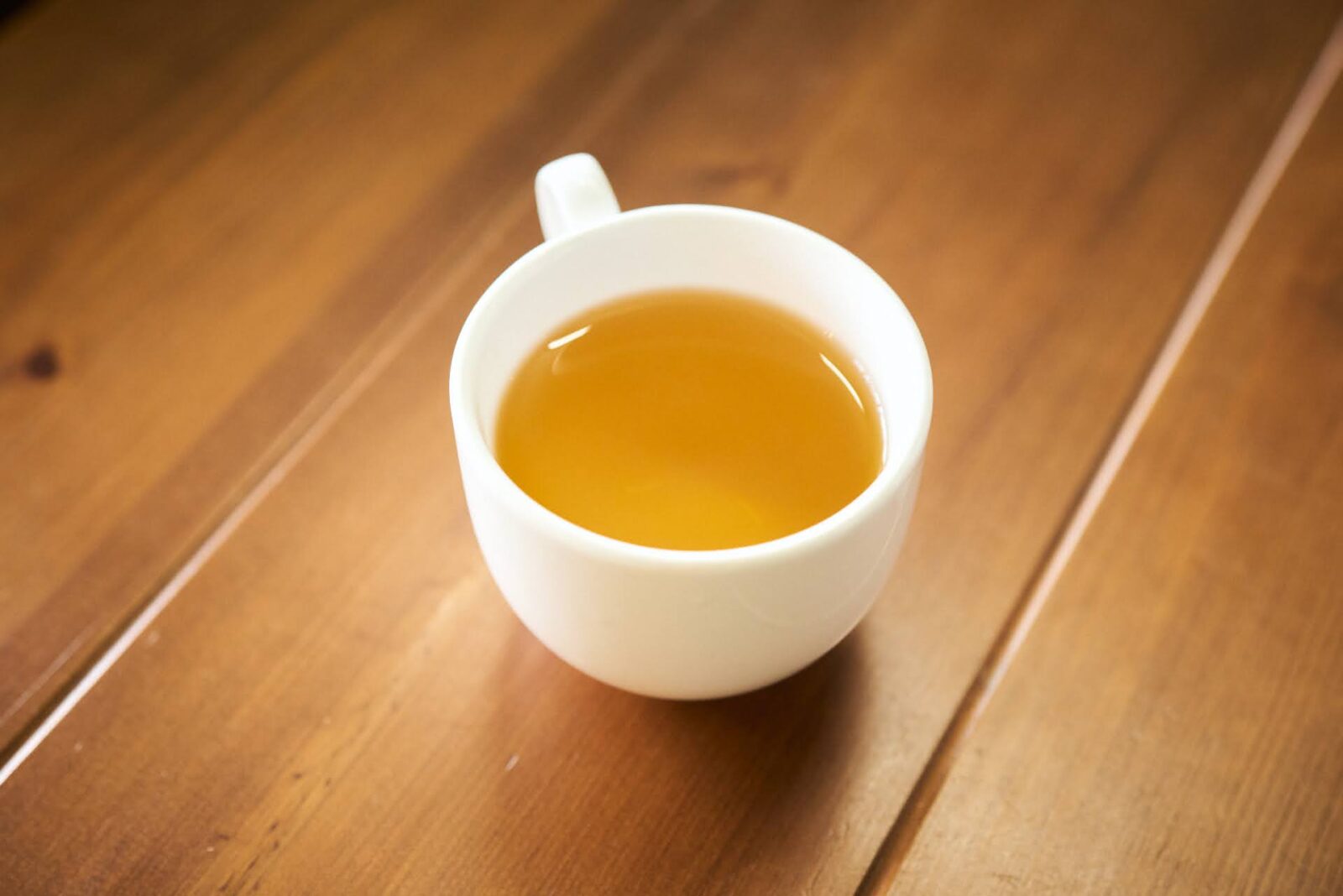
Shimoji blended this herbal tea blend himself. One would imagine that a medicinal tea would taste bitter so people may shy away from it, but this tea is very mild and delicious to drink.
“Tea is very good for the body. Unlike medicine, no matter how much you consume there are no side effects. And it comes with the peace of mind that it is made with all natural ingredients.”
There is a cafe/restaurant and shop on the premises of the herb garden and they hold herb tea blending workshops there.
Each of the jars that are lined up in the shop contain a different type of dried herb, allowing the visitors to make their own original blend tea.

Shimoji encourages us, “Blend whatever you like and make your original herbal tea. If you find a delicious combination, please tell me about it.”
It was not easy deciding on the color, fragrance and flavor among the many available herbs to make an original blend, but it was very fun and we all became absorbed in the process.
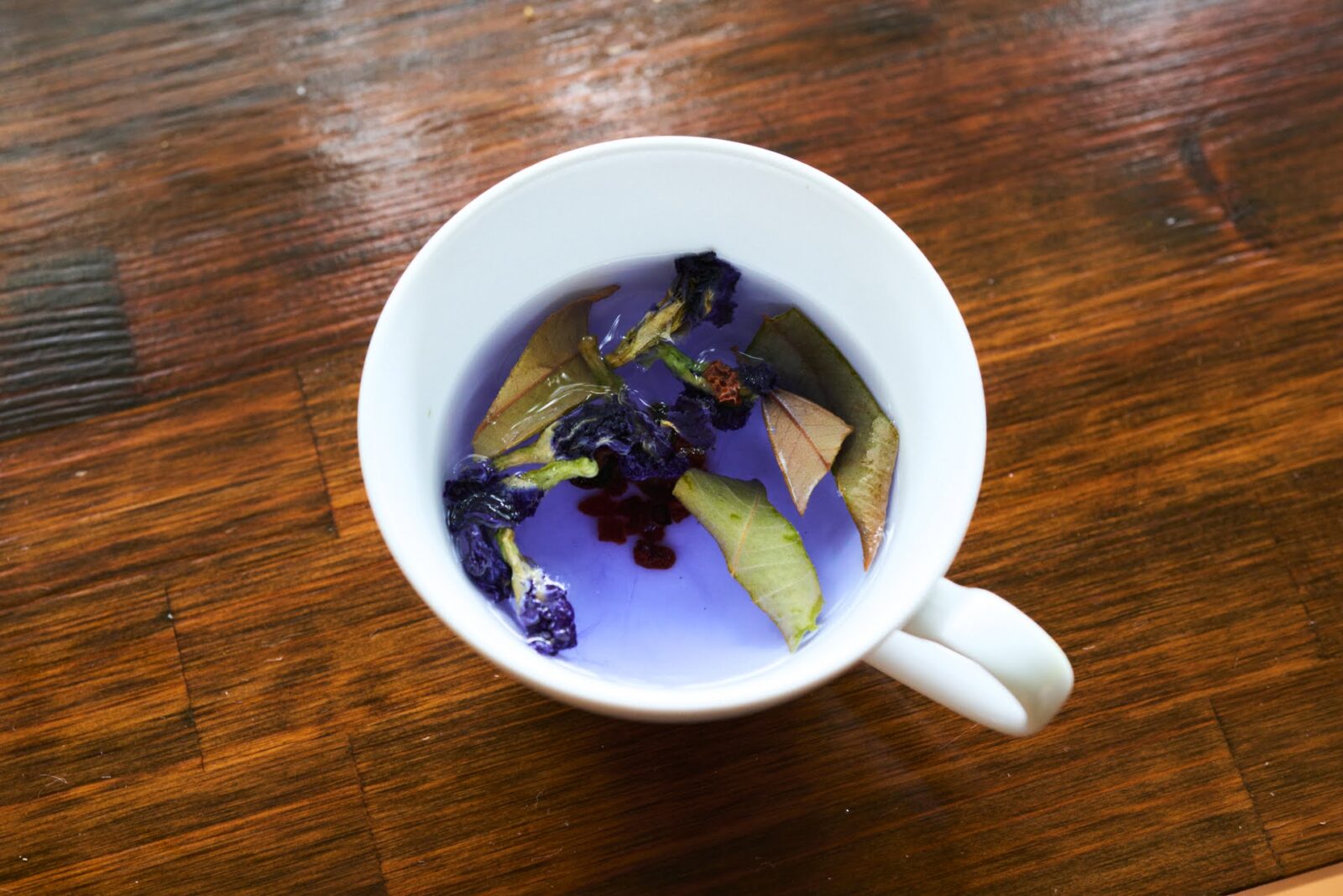
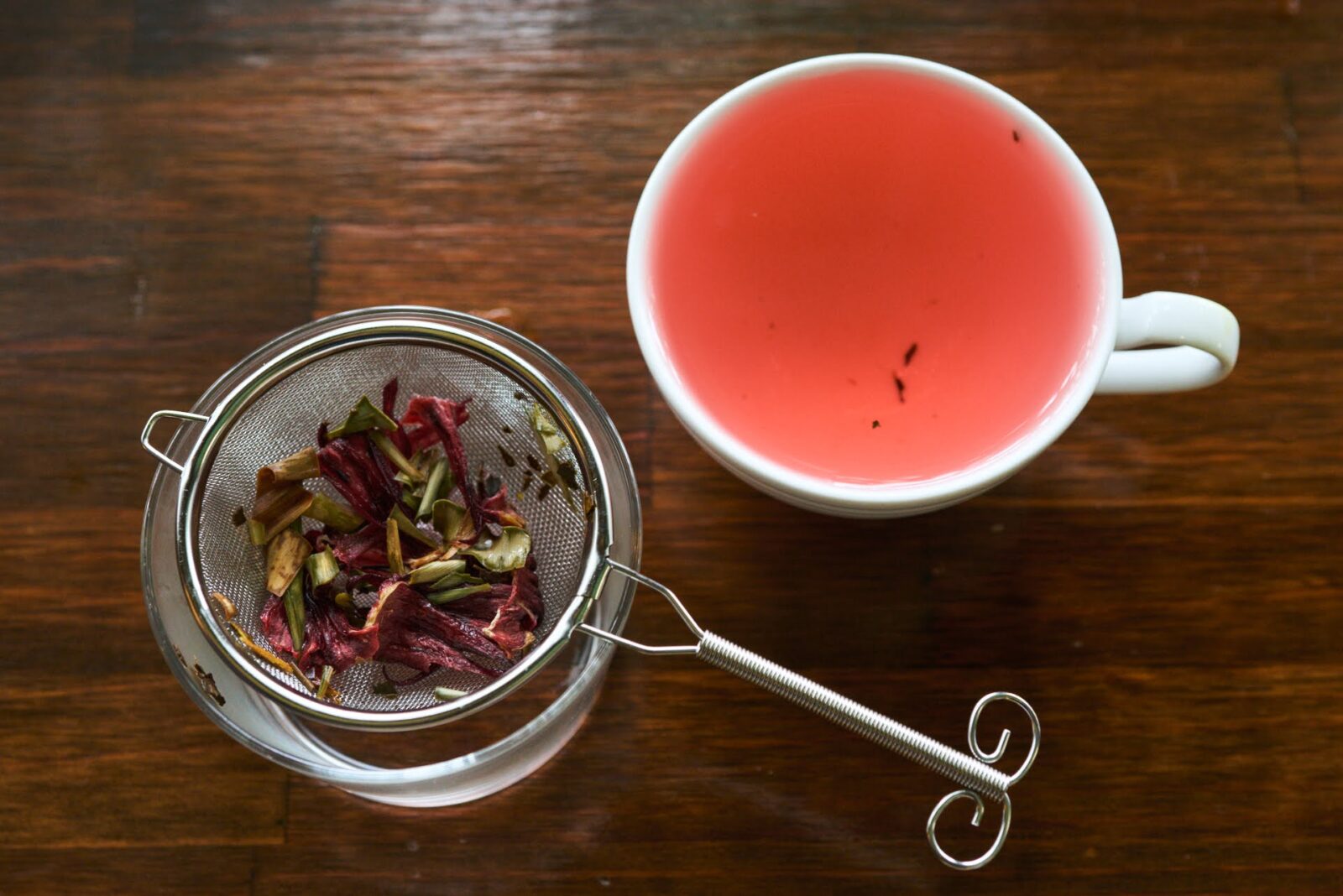
As we immersed ourselves in the rich nature of Okinawa and used our five senses to experience the herbs, we began to understand why Shimoji is so fascinated by medicinal plants.
Delivering health to people through the power of medicinal plants
After touring the herb garden, Shimoji served us a heap of fresh salad with a variety of vegetables.
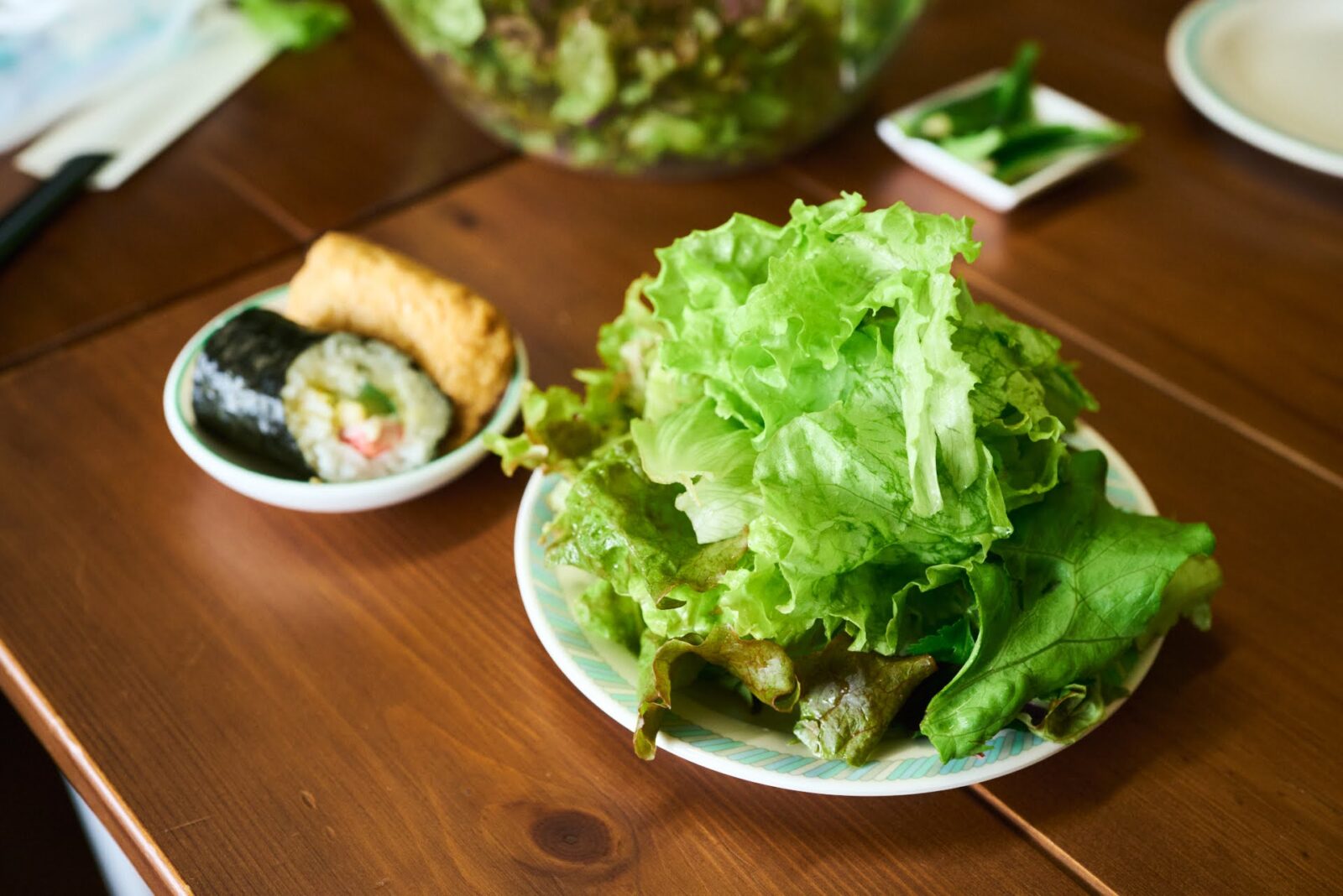
Everything in the salad was harvested from the herb garden. It included leaves with strange shapes we had never seen before, but all of the vegetables were delicious. The salad even included medicinal plants that are beneficial to the body.
As we picked the fresh leaves and medical plants and tasted them, we understood that even the vegetables here are a kind of medicinal plant.
“The people of Okinawa believe that “food is medicine” and still use medicinal plants for health purposes. If you look closely, you can even find medicinal plants growing on the side of the roads.”
Medicinal plants are a part of their connection and relationship with food. There is an old saying in Okinawa, “nuchi gusui” (nuchi=life, gusui=medicine) meaning the “medicine of life”. It is used for things that give people physical and mental energy.
Foods that are delicious and healthy are “nuchi gusui”. There are countless such energizing and powerful foods in Okinawa. Shimoji says, “Food is what sustains life itself.”
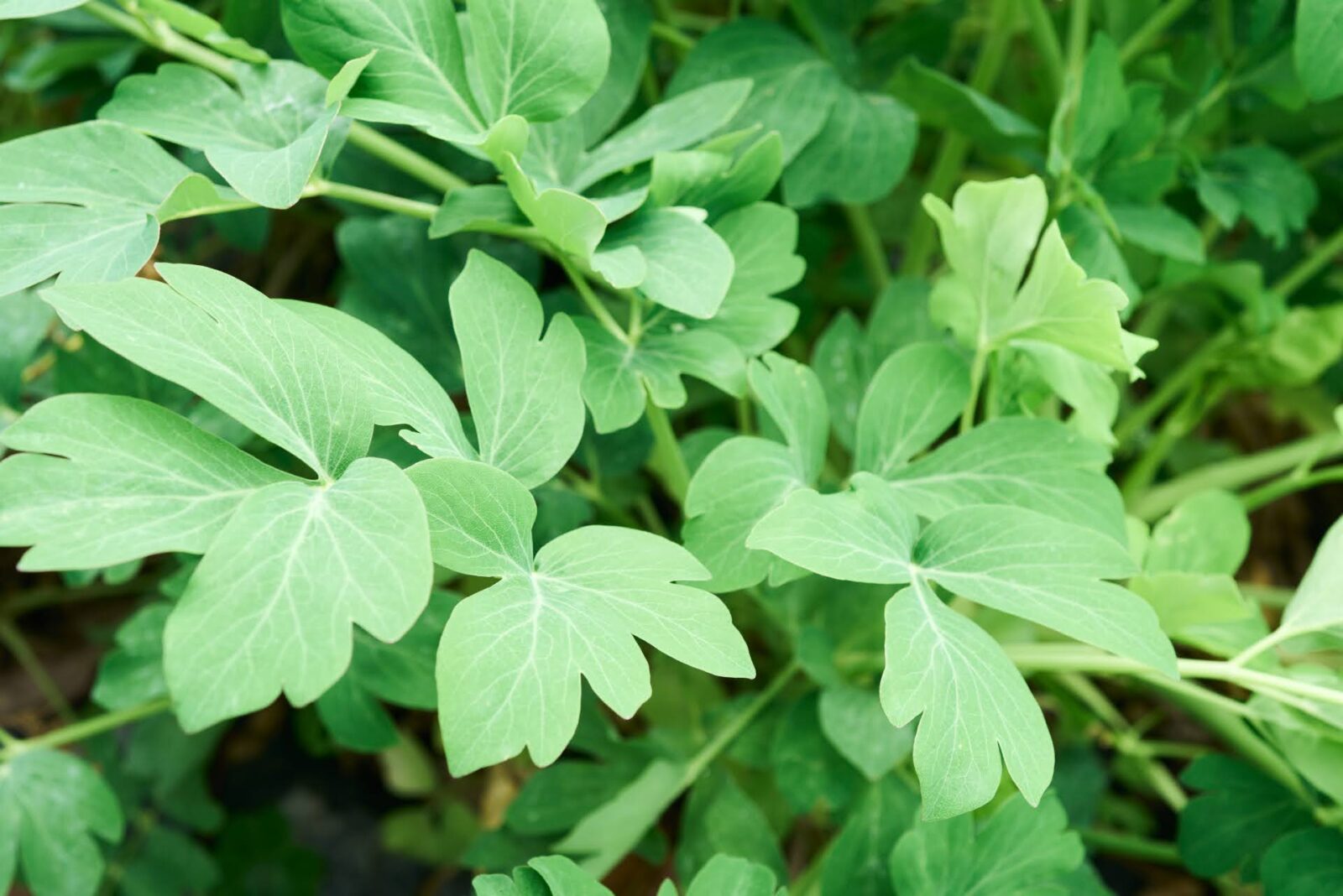
The oldest book on medicine in China is called Shennong Bencaojing. Shennong is a Chinese God from 4,000~5,000 years ago who is worshiped as the ancestral god of medicine.
It is said that he consumed many plants in order to experiment if they are poisonous or beneficial to humans. He identified many medicinal plants which later saved the lives of many people.
The Shennong Bencaojin is a compilation based on his legacy. According to this book there are 365 plants, animals and minerals that are listed as medicinal, the same number as the number of days in a year. The medicine is divided into three categories, the upper medicines (which saves lives and can be taken for long periods of time), the middle medicines (which are effective in preventing and treating illness but can be poisonous if misused) and the lower medicines (which can be used to treat illnesses but are also highly toxic and cannot be used for long periods of time).
Modern classification of medicine is similar to this and the book is said to have provided the basis for the development of modern medicine.
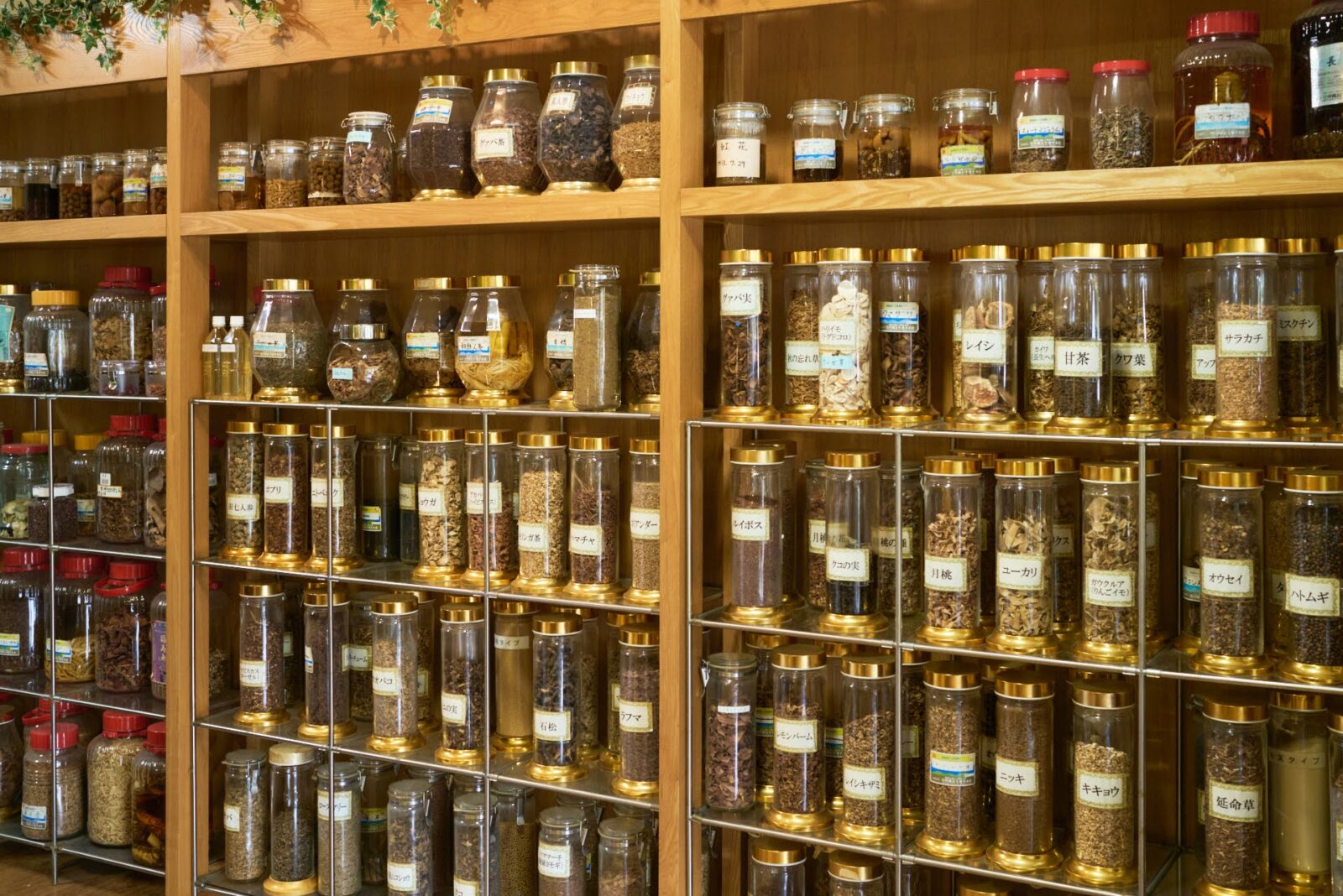
Shimoji only handles plants that are in the upper medicine category, which is harmless even when taken over longer periods of time. He works with various universities from around Japan to study and research the effects, efficacy and safety of medicinal plants. He showed us the many research papers that he has contributed to.
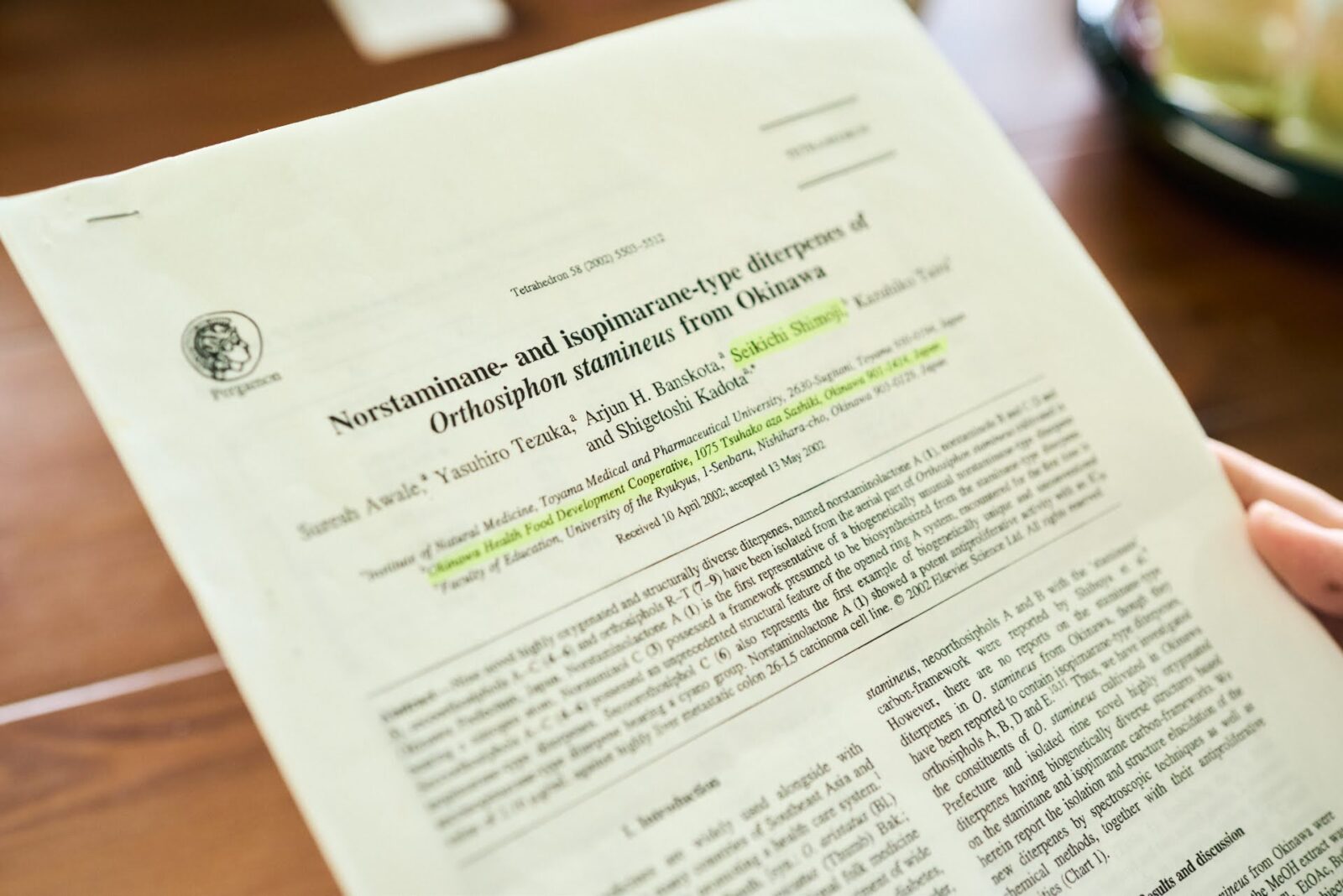
Shimoji has an insatiable enthusiasm in his pursuit to study medicinal plants, but what is the driving force behind his passion?
“For me this is not only my job, but also my joy. I am doing what I really love. No matter how hard I have to work, I can enjoy it because it brings me happiness. I simply do what brings me joy, for the sake of not only myself, but for the world and humanity as a whole.”
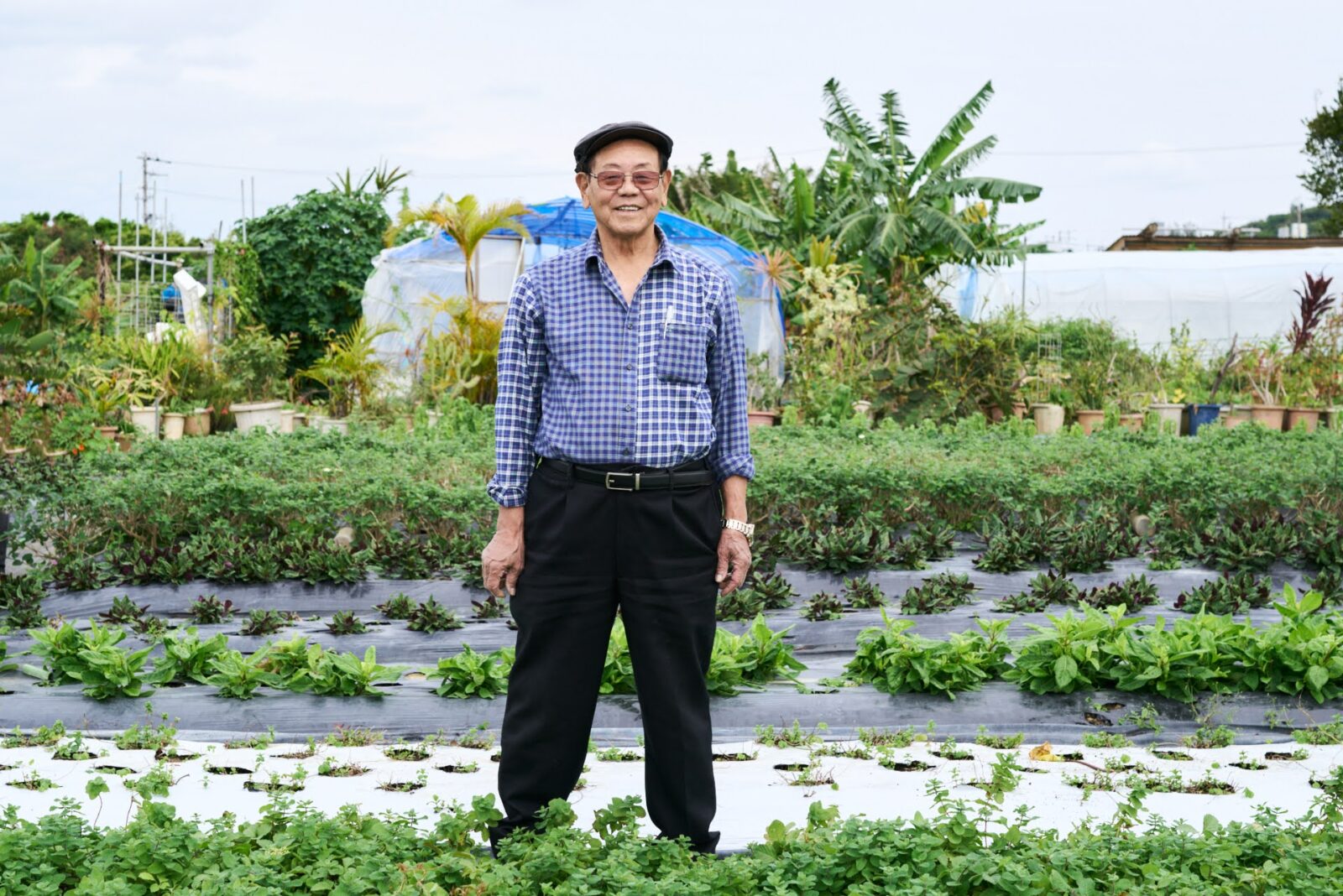
In a pursuit to bring health and happiness to as many people as possible Shimoji’s company shares the slogan of “sincerity, cleanliness and hard work”.
Shimoji himself works in the garden everyday and devotes himself to growing the best medicinal plants. Perhaps he is the modern day Shennong. His vast garden has a mysterious power about it and if you have the chance to travel to Okinawa, please visit and experience its wonders.
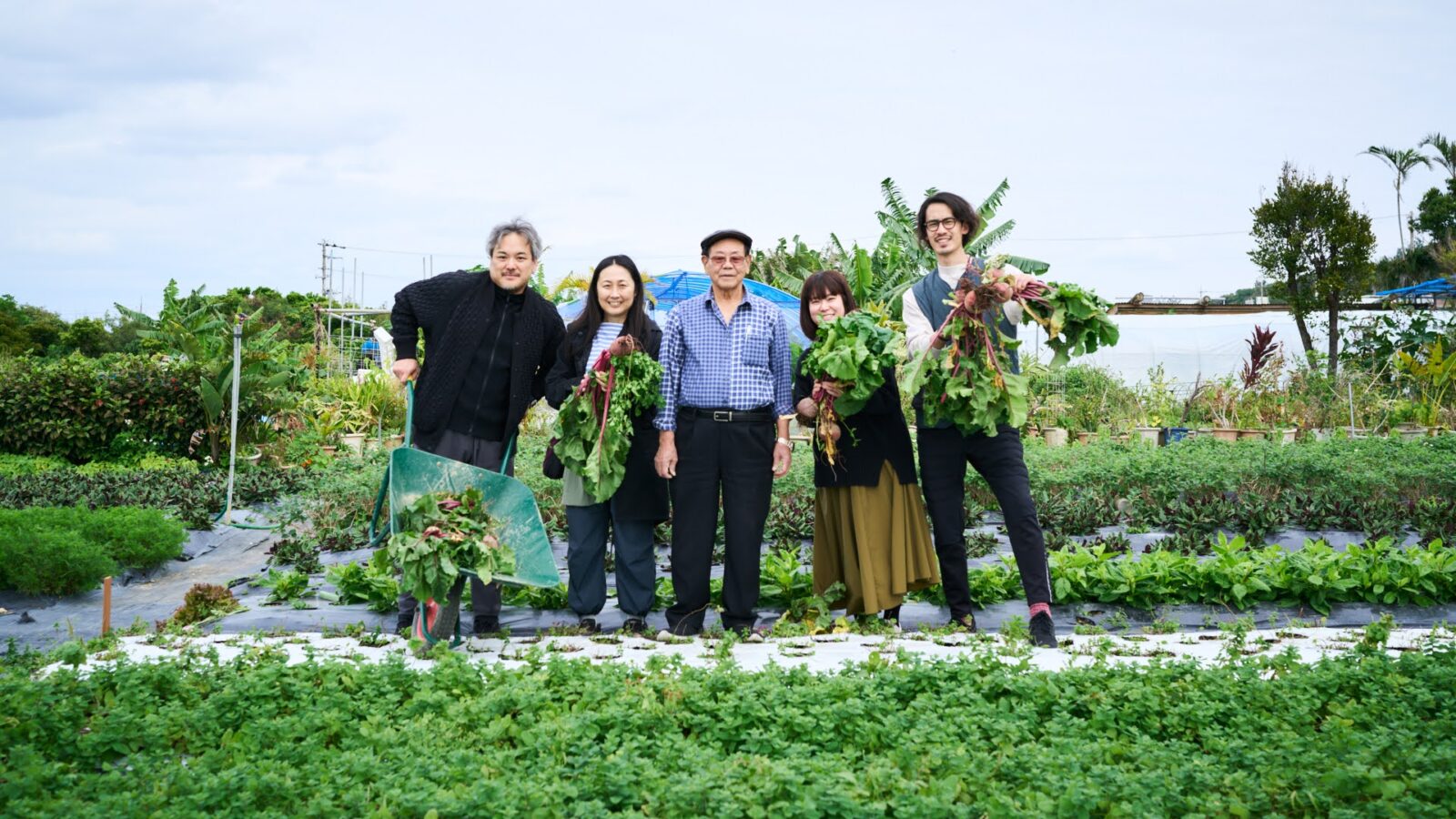
Translation: Sophia Swanson
Advisor to corporations, and local governments on promoting local tourism. Published work includes, “Aomori & Hakodate Travel Book” (Daimond), “San’in Travel: Craft and Food Tour” (Mynavi), “A Drunkard’s Travel Guide: Sake, Snacks, and Tableware Tour” (Mynavi). Her life work is to explore towns in her travels, drink at different shops and visit the workshops of different crafts. Interests include tea, the Jomon period, architecture, and fermented foods.
Editor. Born and raised in Kagoshima, the birthplace of Japanese tea. Worked for Impress, Inc. and Huffington Post Japan and has been involved in the launch and management of media after becoming independent. Does editing, writing, and content planning/production.
